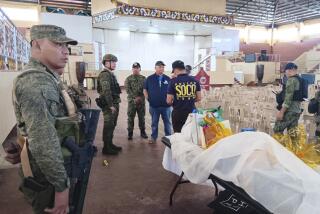Link Seen in Attacks on Bali, Diplomat
- Share via
JAKARTA, Indonesia — The previously unsolved bombing of the Philippine ambassador’s residence here in 2000 was the work of terrorism suspects who helped carry out the deadly Bali bombings two years later, police said Tuesday.
Police named 14 people -- many of them known members of the regional terrorist group Jemaah Islamiah -- as suspects in the car bombing that killed two people and severely wounded the ambassador, Leonides Caday, in August 2000.
Among the suspects is Indonesian cleric Riduan Isamuddin, better known as Hambali, the operations leader of Jemaah Islamiah, who is wanted by police in at least four countries. Police say he planned and financed the bombing at the ambassador’s residence.
It now appears that the bombing was one of the earliest attacks carried out by Jemaah Islamiah and could have served as a practice run for the Bali attack and other deadly bombings in Indonesia and the Philippines.
However, it wasn’t until the bombing of two nightclubs in Bali killed 202 people on Oct. 12 that the Indonesian government began to take the Jemaah Islamiah threat seriously.
Most of the 14 suspects went on to play a role in one or more of Jemaah Islamiah’s subsequent bombings, authorities say, which targeted metro stations and shopping malls in Manila and churches, a shopping mall, a McDonald’s restaurant and nightclubs in Indonesia. The group is responsible for at least 250 deaths in the region.
Police said the bombers tried to kill Ambassador Caday in retaliation for the Philippine army’s attack a few weeks earlier on a large military camp run by the rebel group Moro Islamic Liberation Front in the southern Philippines.
Evidence subsequently seized by police indicates that Jemaah Islamiah operated its own training facility at the Philippine base, which was known as Camp Abubakar.
At least two Indonesians accused of playing a key role in the Caday bombing spent considerable time at the training camp, authorities say.
One was Imam Samudra, who later allegedly served as field coordinator of the Bali bombing. Samudra was arrested last year and is awaiting trial. Police say he also helped organize a series of church bombings on Christmas Eve 2000 that killed 19 people.
The second was Fathur Rohman Al-Ghozi, also known as Mike the Bombmaker, who trained other terrorists at the camp. He was arrested last year in the Philippines and sentenced to at least 10 years on explosives charges. He is awaiting trial on charges that he helped organize a series of bombings in Manila on Dec. 30, 2000, that killed 22 people.
Officials in Manila said this week that Al-Ghozi has admitted that he was the one who detonated the car bomb as Caday was arriving at his residence. The blast killed a guard and a woman passing by, but Caday survived.
Another suspect in the attack is an Indonesian named Amrozi, who authorities say has admitted buying the minivan and chemicals used in the Bali nightclub bombings. Police say he also obtained the car and the chemicals for the bomb detonated at the ambassador’s house. He was arrested last year and is awaiting trial in Bali.
Police say a suspect using the name Dulmatin helped assemble the Caday car bomb. Authorities say he also helped put together the massive car bomb that destroyed the Sari nightclub and killed most of the victims in Bali. He remains at large.
More to Read
Sign up for Essential California
The most important California stories and recommendations in your inbox every morning.
You may occasionally receive promotional content from the Los Angeles Times.













